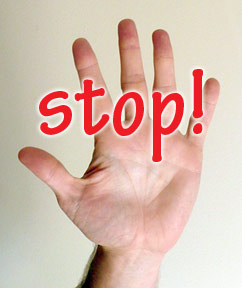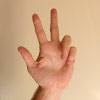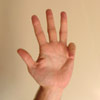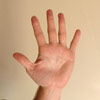Rating of Perceived Exertion (RPE) Scales are commonly used for subjective measures of exercise intensity levels. They are used in research studies and training programs to describe the intensity of exercise. Presented here is a novel 5-Point Rating of Perceived Exertion Hand Scale (RPE-5) that is simple to use and understand. See also my 10 point RPE hand scale.
Although this method is based on the traditional Borg Rating Scales, it is something I created and it has not been scientifically validated. You should also look at the two original (and scientifically validated) RPE scales as developed by Borg: the RPE Scale between 1-10 with ratings from 0 (nothing at all) and 10 (extremely hard) and another RPE scale with the RPE scale between 6-20.

My Five Point Scale
You may ask why do we need another RPE scale when there are others that are well used and scientifically tested? This RPE scale was created for a bit of fun, but it also may serve a purpose, and has some advantages over the other scales, and may be useful to someone one day. For this RPE Scale, the subject just holds up the fingers of their hand to indicate the intensity level - from 1 to 5. The benefits of my scale:
- Is that it is so simple to use, and can be used without a printout - all you need is a hand.
- The 'thumbs up' sign is fairly universally used to indicate that you are doing OK, while the five fingers hand out is also a familiar signal for stopping.
- The 5-point Likert scale is familiar to a lot of people.
- It is non-verbal, so is great for research where the subject is unable to talk such as when they are wearing a VO2 gas collection mask.
| Rating | Long Description |
|---|---|
1. not all all hard |
I’m feeling great and could keep up this pace all day long. |
2. slightly hard |
I’m still comfortable, but am breathing a little harder and starting to sweat. |
3. moderately hard |
This is a good workout. |
4. very hard |
It is getting pretty tough, I could only keep at this pace for a short time period. |
5. Extremely hard |
It's too hard, I need to STOP! |
Notes
- As far as I know such a RPE scale as the above RPE-5 Scale has not been scientifically tested and validated, though the Likert Scale has. You should use with caution, particularly if it is for scientific research that is to be peer reviewed.
- Let me know if you are to use this RPE scale for research. See my other Sport Science research project ideas.
- This scale was created in Sept 2010. Copyright Rob Wood of Topend Sports.
Related Pages
- See more about using the RPE scales, and details of the other RPE Scales: RPE Scale between 1-10 and the similar RPE scale 6-20.
- Rating-of-fatigue (ROF) — a scale to rate how fatigued someone is feeling.
- Reps in Reserve (RIR) — how many more strength lifts can you do?
- Other athlete questionnaires
- About the Likert Scale
- Other Sport Science research project ideas.


 Current Events
Current Events